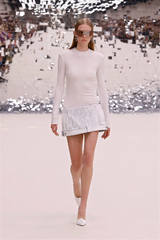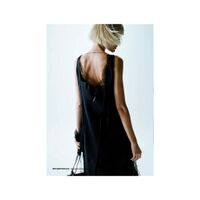FashionGAN
Introduction
Je me suis mis en groupe avec Romane, erreur.
Motivation
The project began with a shared goal: changing how fashion designers work. Understanding the changing fashion landscape, our team aimed to innovate and tackle a common challenge: the search for new ideas and simpler design methods.
We wanted to empower designers with a modern tool that goes beyond traditional limits. We envisioned an AI-powered tool not only creating new clothing designs but also inspiring designers looking for fresh ideas.
Our project focuses on an AI-driven platform generating unique clothing visuals. By combining technologies like DragGAN and AutoEncoder, designers can access and personalize these designs to match their artistic vision.
In essence, we aim to offer designers a valuable resource that nurtures creativity, fosters experimentation, and speeds up design work. Our tool aims to be a catalyst for transformative innovation in the fashion industry by opening up limitless possibilities for designers.
Deliverables
Dataset
A folder with 8249 images from 266 fashion shows, scraped from NowFashion. The images are cleared and converted. We removed the pictures where a face wasn't recognized by our algorithm, and converted all the pictures to 256x256 pixels, as the images need to be square with a number of pixels that is a power of 2. To go with our weak ressources, we chose 256 pixels instead of a more convenient 1024 pixels.
Software
Milestones and Project plan
Milestones
Milestone 1: DragGAN
- Understand how DragGAN works
- Find a dataset that would be appropriate for our utilization
- Train StyleGAN
Milestone 2: Texture swap
- Find a way to apply a texture change on an image
- Train the Swapping Autoencoder for Deep Image Manipulation
- Implement the Texture swap interface in our project
Milestone 3: User Interface
- Change DragGAN's interface to make it more intuitive for our project
Milestone 4: Deliverables
- Deliver the code on Github
- Write the wiki page
- Prepare the presentations
Project Plan
| Week | Tasks | Completion |
|---|---|---|
| Week 3 |
|
✓ |
| Weeks 4-5-6 |
|
✓ |
| Weeks 7-8-9 |
|
✓ |
| Week 10 |
|
✓ |
| Week 11 |
|
✓ |
| Week 12 |
|
|
| Week 13 |
|
Methods
For our project, we're basing ourselves on the DragGAN project (https://github.com/XingangPan/DragGAN), into which we're importing a StyleGAN model that has trained our database.
Scraping
We scraped the images from the NowFashion website, containing an enormous list of fashion shows and pictures of their clothes. We scraped using the selenium library, by iterating on all shows and saving the websites. A big majority of the pictures are in the same format and have the same "frame" (the models appear in the same way in the picture).
But eventually, there are some picture completely different of the others that we wanted to erase.
The best idea we found to find these was to use a face recognizer. So, we removed the pictures where a face wasn't recognized by our algorithm, and converted all the pictures to 256x256 pixels, as the images need to be square with a number of pixels that is a power of 2. To go with our weak ressources, we chose 256 pixels instead of a more convenient 1024 pixels. All the code is available on our Github.
Copyright
The images used in this project are scraped from NowFashion illegaly. We've used these images purely and simply for learning and studying pruposes. If we had wanted to publish a paper or go further, we would have had to either contact nowfashion and find a way to legally have an access to these images, or find another source of images.
DragGAN
DragGAN is a pioneering deep learning model designed for unprecedented controllability in image synthesis. Unlike prior methods reliant on 3D models or supervised learning, DragGAN empowers users to interactively manipulate images by clicking handle and target points, moving them precisely within the image. By utilizing GAN feature spaces, this approach allows for diverse and precise spatial attribute adjustments across various object categories. The model enables efficient, real-time editing without additional networks, facilitating interactive sessions for layout iterations. Evaluated extensively across diverse datasets, DragGAN showcases superior manipulation effects, deforming images respecting underlying object structures, outperforming existing methods in both point tracking and image editing.
StyleGAN
StyleGAN is a type of generative adversarial network (GAN) developed by NVIDIA that's primarily used for generating high-quality, realistic images. It's renowned for its ability to create lifelike human faces, animals and objects. On all versions of StyleGAN that exists, we chose to work with StyleGAN2-ADA (https://github.com/NVlabs/stylegan2-ada-pytorch), based on StyleGAN2. It is less powerfull than StyleGAN3, but regarding our ressources a model based on StyleGAN2 is more appropriate. ADA stands for "adaptive discriminator augmentation", it signifies that this model is better suited for smaller datasets (for example, StyleGAN2-ADA aims to have the same results than the original model with a 30k datasets instead of 100k).
Limitations
There were several unexpected issues during our attempt to train StyleGAN with our dataset. Without going into details, the different problems we encountered were related to :
- Wrong OS
- Use GPU
- Wrong compiler used
- Not allowed to install modules/libraries
Due to these issues, we've been able to start the training only 24 hours before the limit hour to write our wiki page. So the result we share here are unfortunately below the result we could have had with a little more time of training. Also, to have the best results in a minimum of time, we also chose to diminush the resolution of the pictures so the training would take less time. Also, when rescaling the images from the original resolution, we needed to make a choice as the original images were not square : crop them, add stripes on the sides or stretch them. We decided to start by adding stripes, aiming to test the training with these stripes and to also try the other options to compare.
TALK ABOUT FAILURE OF DRAGGAN : maybe fakes not trained enough => bad quality => draggan fails //// images to much same format, not enough difference between images => draggan isn't able to modify based on the database

